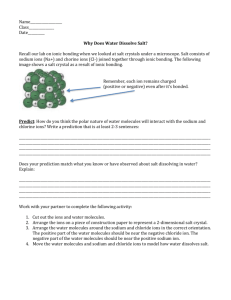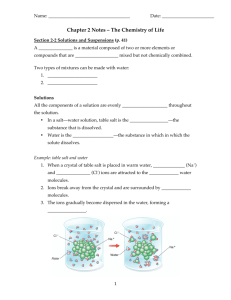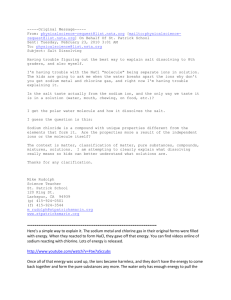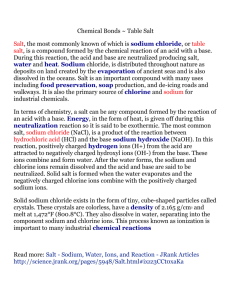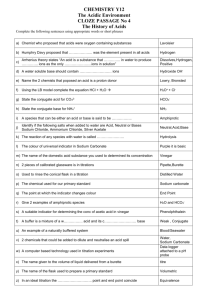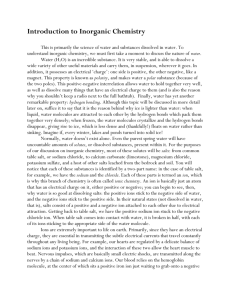Chapter 5, Lesson 3—Why Does Water Dissolve Salt?
advertisement
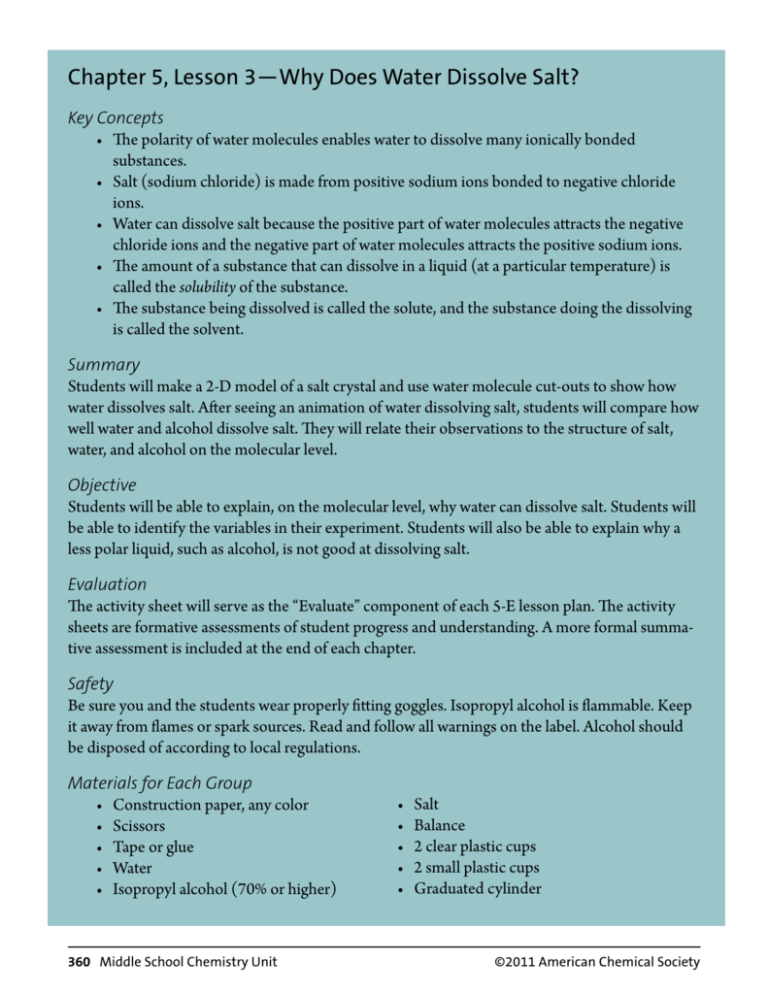
Chapter 5, Lesson 3—Why Does Water Dissolve Salt? Key Concepts • The polarity of water molecules enables water to dissolve many ionically bonded substances. • Salt (sodium chloride) is made from positive sodium ions bonded to negative chloride ions. • Water can dissolve salt because the positive part of water molecules attracts the negative chloride ions and the negative part of water molecules attracts the positive sodium ions. • The amount of a substance that can dissolve in a liquid (at a particular temperature) is called the solubility of the substance. • The substance being dissolved is called the solute, and the substance doing the dissolving is called the solvent. Summary Students will make a 2-D model of a salt crystal and use water molecule cut-outs to show how water dissolves salt. After seeing an animation of water dissolving salt, students will compare how well water and alcohol dissolve salt. They will relate their observations to the structure of salt, water, and alcohol on the molecular level. Objective Students will be able to explain, on the molecular level, why water can dissolve salt. Students will be able to identify the variables in their experiment. Students will also be able to explain why a less polar liquid, such as alcohol, is not good at dissolving salt. Evaluation The activity sheet will serve as the “Evaluate” component of each 5-E lesson plan. The activity sheets are formative assessments of student progress and understanding. A more formal summative assessment is included at the end of each chapter. Safety Be sure you and the students wear properly fitting goggles. Isopropyl alcohol is flammable. Keep it away from flames or spark sources. Read and follow all warnings on the label. Alcohol should be disposed of according to local regulations. Materials for Each Group • Construction paper, any color • Scissors • Tape or glue • Water • Isopropyl alcohol (70% or higher) 360 Middle School Chemistry Unit • • • • • Salt Balance 2 clear plastic cups 2 small plastic cups Graduated cylinder ©2011 American Chemical Society Materials Note: You may choose to laminate the water molecules, sodium ions, and chloride ions located on the last page of the activity sheet so that you can reuse them with your students next year. ENGAGE 1. Make a model of a salt crystal. Project the image Sodium Chloride Crystal. www.middleschoolchemistry.com/multimedia/chapter5/ lesson3#sodium_chloride_crystal Remind students that the green balls represent negative chloride ions and the gray balls represent positive sodium ions. Ask students: • What is it about water molecules and the ions in salt that might make water able to dissolve salt? The positive and negative polar ends of a water molecule are attracted to the negative chloride ions and positive sodium ions in the salt. Give each student an activity sheet. Students will record their observations and answer questions about the activity on the activity sheet. The Explain It with Atoms & Molecules and Take It Further sections of the activity sheet will either be completed as a class, in groups, or individually, depending on your instructions. Look at the teacher version of the activity sheet to find the questions and answers. Question to Investigate How does salt dissolve in water? Materials • Activity sheet with sodium and chloride ions and water molecules • Construction paper, any color • Scissors • Tape or glue Procedure Make a model of a salt crystal 1. Cut out the ions and water molecules. 2. Arrange the ions on a piece of construction paper to represent a 2-D salt crystal. Do not tape these pieces down yet. ©2011 American Chemical Society Middle School Chemistry Unit 361 2.Project an image and have students model what happens when salt dissolves in water. Show students a series of four pictures to help explain the process of water dissolving salt. Project the image Sodium Chloride Dissolving in Water. www.middleschoolchemistry.com/multimedia/chapter5/lesson3#sodium_chloride_dissolving Point out that several water molecules can arrange themselves near an ion and help remove it from the crystal. Show students that the positive area of a water molecule will be attracted to the negative chloride ion and that the negative area of a water molecule will be attracted to the positive sodium ion. Model how water dissolves salt 1. Look at the pictures showing how water molecules dissolve salt. Then arrange the water molecules around the sodium and chloride ions in the correct orientation. The positive part of the water molecules should be near the negative chloride ion. The negative part of the water molecules should be near the positive sodium ion. 2. Move the water molecules and sodium and chloride ions to model how water dissolves salt. 3. Tape the molecules and ions to the paper to represent water dissolving salt. 362 Middle School Chemistry Unit ©2011 American Chemical Society Project the animation Sodium Chloride Dissolving in Water. www.middleschoolchemistry.com/multimedia/chapter5/lesson3#sodium_chloride_dissolving_video Point out that the water molecules are attracted to the sodium and chloride ions of the salt crystal. Explain that the positive area of a water molecule is attracted to a negative chloride ion. The negative area water of a water molecule is attracted to a positive sodium ion. Dissolving happens when the attractions between the water molecules and the sodium and chloride ions overcome the attractions of the ions to each other. This causes the ions to separate from one another and become thoroughly mixed into the water. Tell students that the amount of a substance that can dissolve in a liquid (at a particular temperature) is called solubility. Point out the similarity in the words dissolve and solubility. Also tell them that the substance that is dissolved is called the solute. The substance that does the dissolving is called the solvent. EXPLORE 3.Have students conduct an experiment to find out whether water or isopropyl alcohol would be better at dissolving salt. Ask students to make a prediction: • Think about the polarity of water molecules and alcohol molecules. Do you think alcohol would be just as good, better, or worse than water at dissolving salt? Discuss how to set up a test to compare how water and alcohol dissolve salt. Be sure students identify variables such as: • Amount of water and alcohol used • Amount of salt added to each liquid • Temperature of each liquid • Amount of stirring Question to Investigate Is alcohol just as good, better, or worse than water at dissolving salt? Materials for Each Group • Water • Isopropyl alcohol (70% or higher) • Salt • Balance • 2 clear plastic cups • 2 small plastic cups • Graduated cylinder ©2011 American Chemical Society Middle School Chemistry Unit 363 Procedure 1. In separate cups, measure two samples of salt that weigh 5 g each. 2. Place 15 mL of water and alcohol into separate cups. 3. At the same time, add the water and alcohol to the samples of salt. 4. Swirl both cups the same way for about 20 seconds and check for the amount of salt dissolved. 5. Swirl for another 20 seconds and check. Swirl for the last 20 seconds and check. 6. Carefully pour off the water and alcohol from the cups and compare the amount of undissolved salt left in each cup. Expected Results There will be less undissolved salt in the cup with the water than the alcohol. This means that more salt dissolved in the water than in the alcohol. EXPLAIN 4.Discuss how differences in the polarity of alcohol and water explain why water dissolves salt better than alcohol. Ask students: • Is alcohol just as good, better, or worse than water Read more about at dissolving salt? polarity in the addiAlcohol does not dissolve salt as well as water does. tional teacher back• How do you know? ground section at the There was more salt left behind in the cup with the end of this lesson. alcohol. • Think about the polarity of water and alcohol to explain why water dissolves more salt than alcohol. Have students look at the models of water and alcohol molecules on their activity sheet. – + Remind students that isopropyl alcohol has an oxygen atom bonded to a hydrogen atom so it does have some polarity but not as much as water. Since water is more polar than alcohol, it attracts the positive sodium and negative chloride ions better than alcohol. This is why water dissolves more salt than alcohol does. Another way of saying this is that the solubility of salt is greater in water than in alcohol. 364 Middle School Chemistry Unit ©2011 American Chemical Society EXTEND 5.Have students compare the solubility of two different ionic substances in water. Compare the solubility of the ionic substances calcium carbonate (CaCO3) and sodium carbonate (Na2CO3) in water. Ask students: • How could you compare the solubility of calcium chloride and calcium carbonate? Students should suggest measuring equal amounts of each substance and adding equal amounts of water at the same temperature. Question to Investigate Do all ionic substances dissolve in water? Materials for Each Group • Sodium carbonate • Calcium carbonate • Water • 2 clear plastic cups • 2 small plastic cups • Balance Procedure 1. Label two clear plastic cups Sodium Carbonate and Calcium Carbonate. 2. Measure 2 g each of sodium carbonate and calcium carbonate and put them in their labeled cups. 3. Measure 15 mL of water into each of two empty cups. 4. At the same time, pour the water into the sodium carbonate and calcium carbonate cups. 5. Gently swirl both cups. Expected Results The sodium carbonate will dissolve, but the calcium carbonate will not. Explain that not all ionically bonded solids dissolve in water. ©2011 American Chemical Society Middle School Chemistry Unit 365 6. Discuss student observations. Ask students: • Do all ionic substances dissolve in water? How do you know? Because calcium carbonate does not dissolve in water, students should realize that not all ionic substances dissolve in water. Explain that on the molecular level, the ions that make up calcium carbonate are attracted so strongly to each other that the attraction by water molecules cannot pull them apart. That is a good thing because calcium carbonate is the material that sea shells and bird eggs are made of. Calcium phosphate is another ionic solid that does not dissolve in water. This is also good because it is the material that bones and teeth are made of. Sodium carbonate breaks apart completely into ions that are incorporated throughout the water, forming a solution. The sodium and carbonate ions will not settle to the bottom and cannot be filtered out of the water. But calcium carbonate does not break up into its ions. Instead it is just mixed in with the water. If given enough time, the calcium carbonate will settle to the bottom or can be filtered out of the water. Sodium carbonate dissolved in water is a good example of a solution, and undissolved calcium carbonate is a mixture, not a solution. Note: The carbonate ion is different from the single-atom ions such as sodium (Na+) and chloride (Cl–) that students have seen so far. The carbonate ion (CO32–) is composed of more than one atom. These types of ions, called polyatomic ions, are made up of a group of covalently bonded atoms that act as a unit. They commonly gain or lose one or more electrons and act as an ion. Another common polyatomic ion is the sulfate ion (SO42–). This ion is part of Epsom salt as magnesium sulfate (MgSO4 ) and many fertilizers as potassium sulfate (K2SO4 ). You can decide if you would like to introduce students to these two common polyatomic ions. 366 Middle School Chemistry Unit ©2011 American Chemical Society
